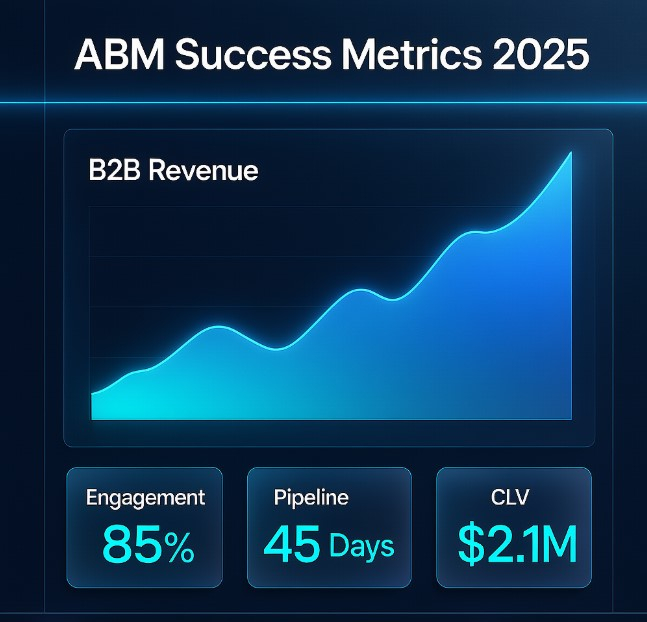Account-Based Marketing (ABM) has become the backbone of modern B2B growth strategies. By aligning marketing and sales around high-value accounts, ABM allows companies to focus their efforts where it truly matters. But in 2025, the effectiveness of ABM isn’t just about execution — it’s about measurement.
Tracking the right ABM metrics ensures your campaigns aren’t just active but actually driving pipeline velocity, account engagement, and revenue outcomes. In this guide, we’ll explore the key metrics every B2B brand must track to optimize ABM performance and maximize ROI.
What Is ABM Measurement and Why It Matters
ABM measurement is the process of tracking and analyzing performance indicators tied to specific accounts instead of general lead metrics. Unlike traditional demand generation, ABM success is not measured by volume — it’s measured by impact.
When done right, ABM metrics provide:
- A clear understanding of how target accounts move through the funnel
- A unified view of marketing and sales performance
- Data-driven insights to refine strategies and personalize outreach
With AI-powered platforms, intent data, and marketing automation shaping 2025’s landscape, measuring ABM accurately has become more sophisticated — and more critical.
Top Metrics to Measure ABM Success
1. Account Engagement Score
One of the primary indicators of ABM effectiveness is how deeply your target accounts are engaging with your brand. Engagement score combines data from multiple touchpoints such as website visits, email interactions, webinar participation, and ad clicks.
Why it matters: A rising engagement score signals strong interest, helping sales teams prioritize outreach effectively.
2. Pipeline Velocity
ABM aims to accelerate deals with high-value accounts. Measuring how quickly accounts move from awareness to closed-won deals reveals the efficiency of your ABM strategy.
Why it matters: Faster pipeline velocity equals more revenue in less time.
3. Account Penetration
This metric tracks how many key stakeholders within a target account are interacting with your brand. ABM isn’t just about one contact — it’s about reaching the buying committee.
Why it matters: Greater penetration means stronger influence across the decision-making unit.
4. Deal Size and Win Rate
Because ABM targets high-value accounts, it typically delivers larger deal sizes and better win rates compared to traditional marketing.
Why it matters: Tracking deal size and win rate helps you prove ABM’s impact on revenue growth.
5. Marketing Qualified Accounts (MQAs)
Unlike MQLs, MQAs reflect entire accounts that meet specific engagement and intent thresholds.
Why it matters: MQAs are a more accurate representation of ABM success than individual leads.
6. ROI and Cost Per Account
The ultimate measure of ABM success is its contribution to revenue versus the cost invested. ROI per account gives clarity on campaign efficiency and helps optimize budget allocation.
Challenges in ABM Measurement
While ABM metrics are powerful, they can also be complex to track. Common challenges include:
- Integrating data across multiple platforms
- Aligning marketing and sales attribution
- Defining meaningful engagement thresholds
- Lack of real-time visibility into account behavior
To overcome these, many B2B organizations in 2025 are adopting AI-driven analytics, real-time dashboards, and predictive modeling to make their ABM measurement smarter.
Proven Strategies to Optimize ABM Metrics
- Set Clear Goals Early: Define what success looks like — pipeline growth, account penetration, or deal acceleration.
- Align Marketing and Sales Teams: Unified teams mean more accurate and actionable data.
- Leverage Intent Data: Knowing when accounts are ready to buy allows for better timing and personalization.
- Automate Reporting: Use ABM platforms and CRM integrations to minimize manual reporting.
- Benchmark Over Time: Don’t just look at numbers — track how they evolve and use them to refine campaigns.
Trends Shaping ABM Measurement in 2025
- Predictive Analytics: AI forecasts pipeline outcomes based on account behavior.
- Real-Time Dashboards: Instant visibility into engagement and conversion.
- Deeper Sales-Marketing Alignment: Shared KPIs are becoming standard.
- Personalization at Scale: Metrics help fine-tune content and offers to specific accounts.
Pro Tips & Bonus Insights
- Don’t measure everything — focus on high-impact metrics.
- Segment accounts by industry, deal size, or engagement level to uncover hidden trends.
- Celebrate micro-conversions — they build momentum toward big wins.
- Use engagement data to predict buying intent and trigger outreach at the perfect moment.
Conclusion
Measuring ABM success isn’t just about tracking numbers — it’s about understanding how target accounts are progressing toward revenue. By focusing on metrics like engagement, pipeline velocity, and ROI, B2B brands can refine their strategies, drive alignment, and achieve predictable growth.
In 2025, the companies that win with ABM are those that measure smartly and act strategically. If your current measurement framework isn’t giving you the clarity you need, it’s time to evolve.
Ready to elevate your ABM strategy with precision metrics? 👉 Connect with Intent Amplify to turn account engagement into revenue growth.
